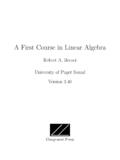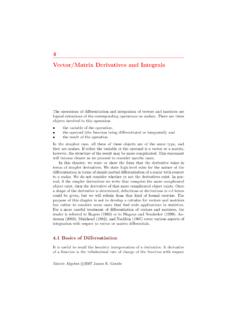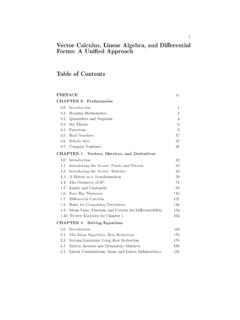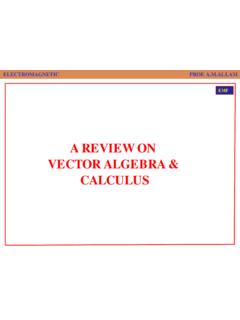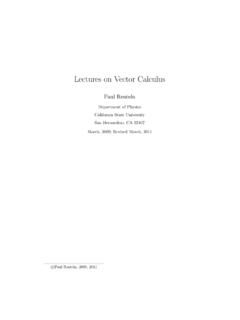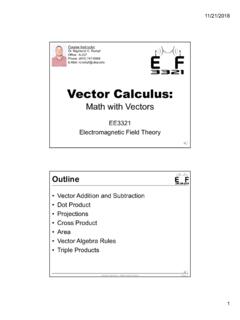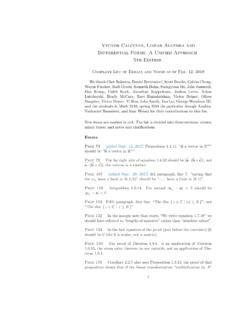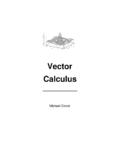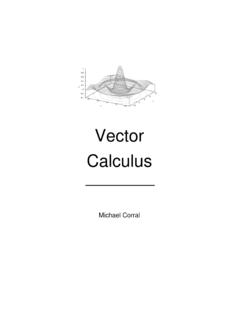Transcription of Exercise and Solution Manual for A First ... - Linear Algebra
1 Exercise and Solution ManualforA First Course in Linear AlgebraRobert A. BeezerUniversity of Puget SoundVersion PressRobert A. Beezer is a Professor of Mathematics at the University of Puget Sound, where he has been on thefaculty since 1984. He received a in Mathematics (with an Emphasis in Computer Science) from theUniversity of Santa Clara in 1978, a in Statistics from the University of Illinois at Urbana-Champaignin 1982 and a in Mathematics from the University of Illinois at Urbana-Champaign in addition to his teaching at the University of Puget Sound, he has made sabbatical visits to the Universityof the West Indies (Trinidad campus) and the University of Western Australia.
2 He has also given severalcourses in the Master s program at the African Institute for Mathematical Sciences, South Africa. He hasbeen a Sage developer since teaches calculus, Linear Algebra and abstract Algebra regularly, while his research interests include theapplications of Linear Algebra to graph theory. His professional website is 7, 2012 Cover DesignAidan MeachamPublisherRobert A. BeezerCongruent PressGig Harbor, Washington, USAc 2004 2012 Robert A. BeezerPermission is granted to copy, distribute and/or modify this document under the terms of the GNU FreeDocumentation License, Version or any later version published by the Free Software Foundation; withno Invariant Sections, no Front-Cover Texts, and no Back-Cover Texts.
3 A copy of the license is included inthe appendix entitled GNU Free Documentation License .The most recent version can always be found of Linear Equations1 What is Linear Algebra ? ..1 Solving Systems of Linear Equations ..1 Reduced Row-Echelon Form ..6 Types of Solution Sets ..13 Homogeneous Systems of Equations ..18 Nonsingular Matrices ..23 Vectors28 Vector Operations ..28 Linear Combinations ..32 Spanning Sets ..33 Linear Independence ..41 Linear Dependence and Spans ..48 Orthogonality ..51 Matrices53 Matrix Operations ..53 Matrix Multiplication ..57 Matrix Inverses and Systems of Linear Equations ..61 Matrix Inverses and Nonsingular Matrices.
4 65 Column and Row Spaces ..67 Four Subsets ..72 Vector Spaces77 Vector Spaces ..77 Subspaces ..80 Linear Independence and Spanning Sets ..84 Bases ..91 Dimension ..95 Properties of Dimension ..99 Determinants101 Determinant of a Matrix .. 101 Properties of Determinants of Matrices .. 104 Eigenvalues106 Eigenvalues and Eigenvectors .. 106 Properties of Eigenvalues and Eigenvectors .. 111 Similarity and Diagonalization .. 113 Linear Transformations117 Linear Transformations .. 117 Injective Linear Transformations .. 121 Surjective Linear Transformations .. 126 Invertible Linear Transformations .. 131iiiRepresentations136 Vector Representations.
5 136 Matrix Representations .. 137 Change of Basis .. 146 Orthonormal Diagonalization .. 149 Archetypes150ivChapter SLES ystems of Linear EquationsSection WILAWhat is Linear Algebra ?C10(Robert Beezer) In Example TMP the First table lists the cost (per kilogram) to manufacture each ofthe three varieties of trail mix (bulk, standard, fancy). For example, it costs $ to make one kilogramof the bulk variety. Re-compute each of these three costs and notice that the computations are Linear (Robert Beezer) In Example TMP two different prices were considered for marketing standard mixwith the revised recipes (one-third peanuts in each recipe).
6 Selling standard mix at $ resulted in sellingthe minimum amount of the fancy mix and no bulk mix. At $ it was best for profits to sell the maximumamount of fancy mix and then sell no standard mix. Determine a selling price for standard mix that allowsfor maximum profits while still selling some of each type of (Robert Beezer) If the price of standard mix is set at $ , then the profit function has a zerocoefficient on the variable quantityf. So, we can setfto be any integer quantity in{825,826, ..,960}.All but the extreme values (f= 825,f= 960) will result in production levels where some of every mix ismanufactured.
7 No matter what value offis chosen, the resulting profit will be the same, at $2, SSLES olving Systems of Linear EquationsC10(Robert Beezer) Find a Solution to the system in Example IS wherex3= 6 andx4= 2. Find twoother solutions to the system. Find a Solution wherex1= 17 andx2= 14. How many possible answersare there to each of these questions?C20(Robert Beezer) Each archetype (Archetypes) that is a system of equations begins by listing somespecific solutions. Verify the specific solutions listed in the following archetypes by evaluating the system ofequations with the solutions A, Archetype B, Archetype C, Archetype D, Archetype E, Archetype F, Archetype G, ArchetypeH, Archetype I, Archetype JC30(Chris Black) Find all solutions to the Linear system:x+y= 52x y= 3 Solution (Chris Black) Solving each equation fory, we have the equivalent systemy= 5 xy= 2x Beezer SSLES etting these expressions foryequal, we have the equation 5 x= 2x 3, which quickly leads tox= forxin the First equation, we havey= 5 x= 5 83=73.
8 Thus, the Solution isx=83,y= (Chris Black) Find all solutions to the Linear system:3x+ 2y= 1x y= 24x+ 2y= 2C32(Chris Black) Find all solutions to the Linear system:x+ 2y= 8x y= 2x+y= 4C33(Chris Black) Find all solutions to the Linear system:x+y z= 1x y z= 1z= 2C34(Chris Black) Find all solutions to the Linear system:x+y z= 5x y z= 3x+y z= 0C50(Robert Beezer) A three-digit number has two properties. The tens-digit and the ones-digit add up to5. If the number is written with the digits in the reverse order, and then subtracted from the original number,the result is 792. Use a system of equations to find all of the three-digit numbers with these (Robert Beezer) Letabe the hundreds digit,bthe tens digit, andcthe ones digit.
9 Then thefirst condition says thatb+c= 5. The original number is 100a+ 10b+c, while the reversed number is100c+ 10b+a. So the second condition is792 = (100a+ 10b+c) (100c+ 10b+a) = 99a 99cSo we arrive at the system of equationsb+c= 599a 99c= 792 Using equation operations, we arrive at the equivalent systema c= 8b+c= 5We can varycand obtain infinitely many solutions. However,cmust be a digit, restricting us to ten values(0 9). Furthermore, ifc >1, then the First equation forcesa >9, an impossibility. Settingc= 0, yields850 as a Solution , and settingc= 1 yields 941 as another (Robert Beezer) Find all of the six-digit numbers in which the First digit is one less than the second,the third digit is half the second, the fourth digit is three times the third and the last two digits form anumber that equals the sum of the fourth and fifth.
10 The sum of all the digits is 24. (FromThe MENSAP uzzle Calendarfor January 9, 2006.) Solution (Robert Beezer) Letabcdefdenote any such six-digit number and convert each requirement inthe problem statement into an 1 SSLEFCLA: Exercises and Solutions3c=12bd= 3c10e+f=d+e24 =a+b+c+d+e+fIn a more standard form this becomesa b= 1 b+ 2c= 0 3c+d= 0 d+ 9e+f= 0a+b+c+d+e+f= 24 Using equation operations (or the techniques of the upcoming Section RREF), this system can be convertedto the equivalent systema+1675f= 5b+1675f= 6c+875f= 3d+825f= 9e+1175f= 1 Clearly, choosingf= 0 will yield the solutionabcde= 563910. Furthermore, to have the variables result insingle-digit numbers, none of the other choices forf(1,2.)

